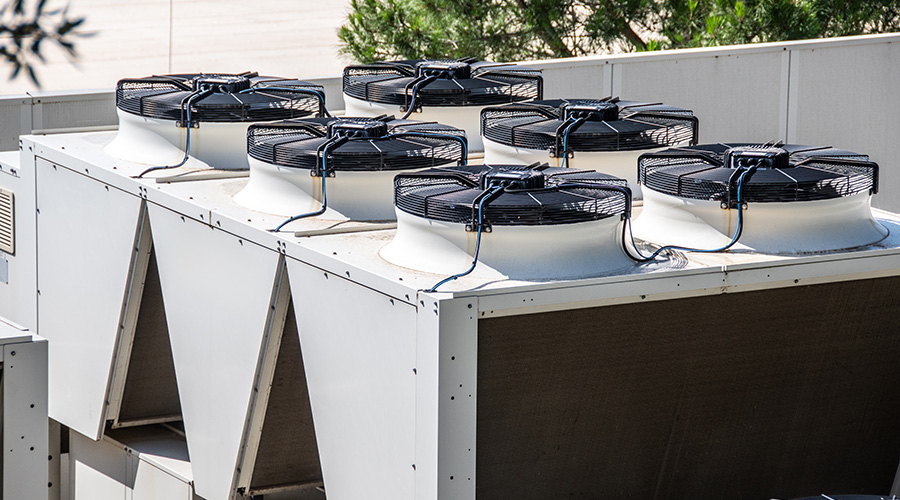Outlook
Four strategies can make HVAC system ally in fight against mold
The HVAC system plays a key role in preventing mold growth in buildings — or in feeding it. Properly designed and maintained systems provide environmental conditions detrimental to mold growth.
But systems that lack certain features and that have not been well maintained provide a breeding ground for mold spores and can spread spores throughout the facility. Once spores spread, the cost of remediation is generally very high.
Often, the difference between the two comes down to a few seemingly small details that must be addressed in the design process.
Mold requires four ingredients for growth: organic nutrients, moisture, a surface to grow on and darkness. Most HVAC systems have many areas where all four ingredients occur abundance. If all four ingredients are present in sufficient quantities, mold will thrive. Take away or limit at least one, and mold will not be a problem.
The best time to address mold issues in HVAC systems is early in the design process. Relatively minor and inexpensive changes that will have a very large impact on the system’s resistance to mold can be made in the system design. Many design changes can also be applied to existing systems, with equally effective results, although a somewhat higher investment is required.
Too many facility executives make the mistake of thinking their facilities are safe from mold simply because they are not located in hot and humid climates. It is true that hot and humid climates increase the risk of mold, but mold can exist in any system in any climate.
Although there are many steps that can be taken to reduce the risk of mold growing in HVAC systems, the four most effective design measures are sloping the drain pan under cooling coils, installing cleanable surfaces within air handlers and ductwork, providing accessibility to critical areas of the system and installing ultraviolet light fixtures in the supply air.
Dealing with condensate
HVAC system condensate drain pans receive little attention during the design process, yet they are critical components in the fight against mold in the system. Located under and downstream from cooling coils, the pans are designed to collect the moisture that condenses on and falls from the coils. When the system is properly designed and well maintained, all of the condensate is collected in the pan and drained away from the system.
The concept is simple, but several things can go wrong, resulting in condensate spilling or being carried into the interior of the air handler and ductwork. For example, if the flow rate across the cooling coil is too high, the condensate can be carried downstream from the coil and pan, soaking the interior of the ductwork. Drain lines from condensate pans can become plugged with dirt and debris, causing the pan to overflow and flood the interior of the air handler and ductwork. Condensate pans can also corrode and leak, flooding the interior of the air handler and ductwork. Once wet, these surfaces will provide an environment for the growth and distribution of mold.
Most installed drain pans are flat or are only slightly sloped, creating the conditions where water can readily pool. These stagnant pools collect dirt and allow the growth of microorganisms, further in-creasing the chances that the pan’s drain line will become clogged.
The most effective drain pan designs are ones that are positively sloped in two directions to provide rapid draining of condensate from the system. These pans use significant slopes to ensure that all condensate is rapidly drained away with no chance of ponding.
The design must also address the pan’s drain line. Drain lines are almost an afterthought, often being sized as small as possible. But the smaller the size of the drain line, the greater the risk of clogs that can lead to flooding. To reduce the risk of flooding from clogging, lines must be oversized and designed to move condensate rapidly and directly away from pans.
To reduce the risk of drawing sewer gases up into the system through the drain line, all lines must be individually trapped at each unit.
Cleanable surfaces
No matter how well systems are designed and maintained, things will go wrong. Equipment will malfunction. Leaks will occur. Dirt will accumulate on coils and duct surfaces. Proper selection of the materials and finishes used in both the air handler and the ductwork can minimize the impact that these situations will have on the operation of the system.
For example, a once-common design practice was to line the interior of ductwork with insulation to reduce energy losses and quiet the operation of the system. Fibrous glass and other types of insulation often found on the interior of air handlers and ductwork tend to trap dirt. Add moisture from the air supply, and the result is a breeding ground for mold. Once mold is present, it is difficult or impossible to remove the dirt because of the porous finish of the insulation.
To limit the buildup of dirt on the interior of air handlers and ductwork, all interior surfaces should be smooth and cleanable. Ductwork should be of double-wall construction, or the insulation should be installed on the exterior surface. No interior insulation should be installed anywhere close to the discharge side of any cooling coil. All insulation installed on the interior side of the system must be of closed cell construction.
Accessibility
An important element in any program to combat the growth and distribution of mold is good maintenance. Key system components, particularly those where mold is likely to develop and grow, must be inspected and cleaned on a regular basis. But if these regular inspections and cleanings are to occur, the areas where those components are located must be easily accessible. A rule of maintenance is equipment that is not easy to maintain won’t be.
Gaining access to the system for inspection and cleaning is a function of system design. Mounting air handlers in tight spaces above ceilings with no access panels or high above floors with no walkways will only make it more likely that inspection and maintenance tasks will be ignored. Before selecting a location for an HVAC system, designers must consider how maintenance personnel will be able to get to it.
Similarly, the system itself must make inspection and maintenance easy. All areas where dirt and moisture are likely to occur, such as in coil and filter sections and at transitions in ductwork, must be equipped with hinged doors and removable panels. Terminal equipment, such as fan coil units, must also include easily removable panels to allow access to filter and condensate pan sections.
Of course, gaining access is only the first step. Maintenance personnel must perform those tasks. Without follow-through, the design features will have been wasted. In most applications, ductwork should be inspected once each year. Coils and the condensate pan should be inspected monthly for leaks and dirt accumulation. In humid climates, more frequent inspections will be required.
Ultraviolet light
Even with good designs, operating practices and maintenance, mold can remain a threat. In some applications, HVAC system managers have installed an ultraviolet lighting system on the duct side of the coils. The ultraviolet light given off by the system kills many airborne microorganisms, including mold, before they can be transported to the building’s conditioned spaces. Units are available for use in both air handlers and terminal units such as fan coils.
If an ultraviolet-light system is installed to help reduce the threat of mold, the system must be carefully matched to the conditions found in that application. Safeguards must be built into the system to prevent the accidental exposure of maintenance personnel to the light. Air velocities within the system must be low enough to allow the light sufficient time to kill the microorganisms.
James Piper, PhD, PE, is a writer and consultant who has more than 25 years of experience in facilities management. He is a contributing editor to Building Operating Management.
More Ways to Fight Mold
There are several general design practices that facility executives can follow to reduce the risk of mold growing in the HVAC system and being distributed to the building. While these practices might seem to be obvious, too often they are overlooked in the design process. Most can be implemented during the design at little or no cost.
It’s important to make certain that the outside air intakes to all air handler systems are located well away from any source of moisture or standing water. Cooling towers and building exhausts generate large volumes of moisture that can be readily drawn into an air handler’s air intake. Both can serve as sources for mold spores and other microorganisms. Even water ponded on a roof can be a source of mold spores and other microorganisms.
If the air intake must be located at the roof, elevate it as much as possible above the surface of the roof.
Also, don’t assume filters are the answer to the mold problem. While mold spores typically are larger than one micron in size and therefore can be removed by air filtration, the problem is that air filters are on the other side of the coil from where most mold is found in HVAC systems.
That does not mean that air filters can be ignored: The dirt that collects on a filter can serve as a breeding ground for mold. Rather, consider filters to be another tool not the solution.
Finally, don’t forget that the system should be designed to provide a slight positive pressure to the building. A slight positive pressurization tends to limit the infiltration of moisture-laden, untreated and unfiltered air. Slight pressurization is particularly important in hot and humid climates.
|
Related Topics:











